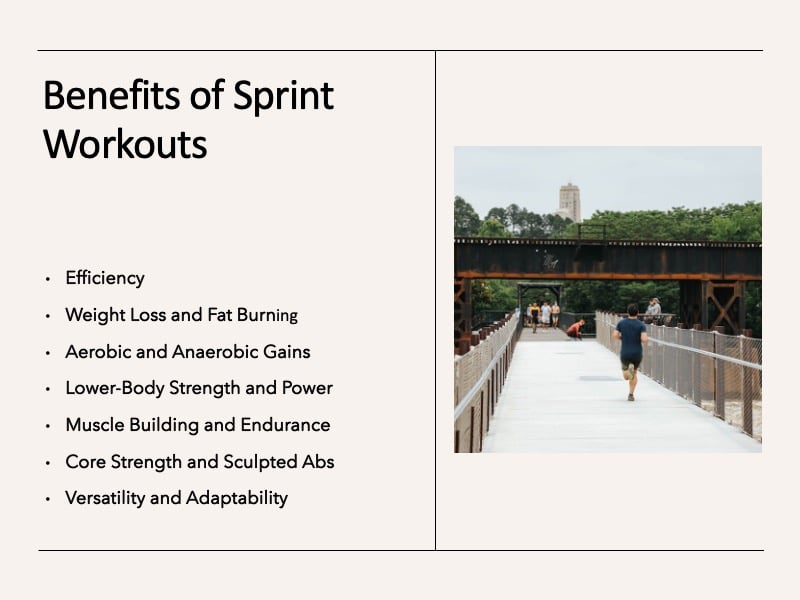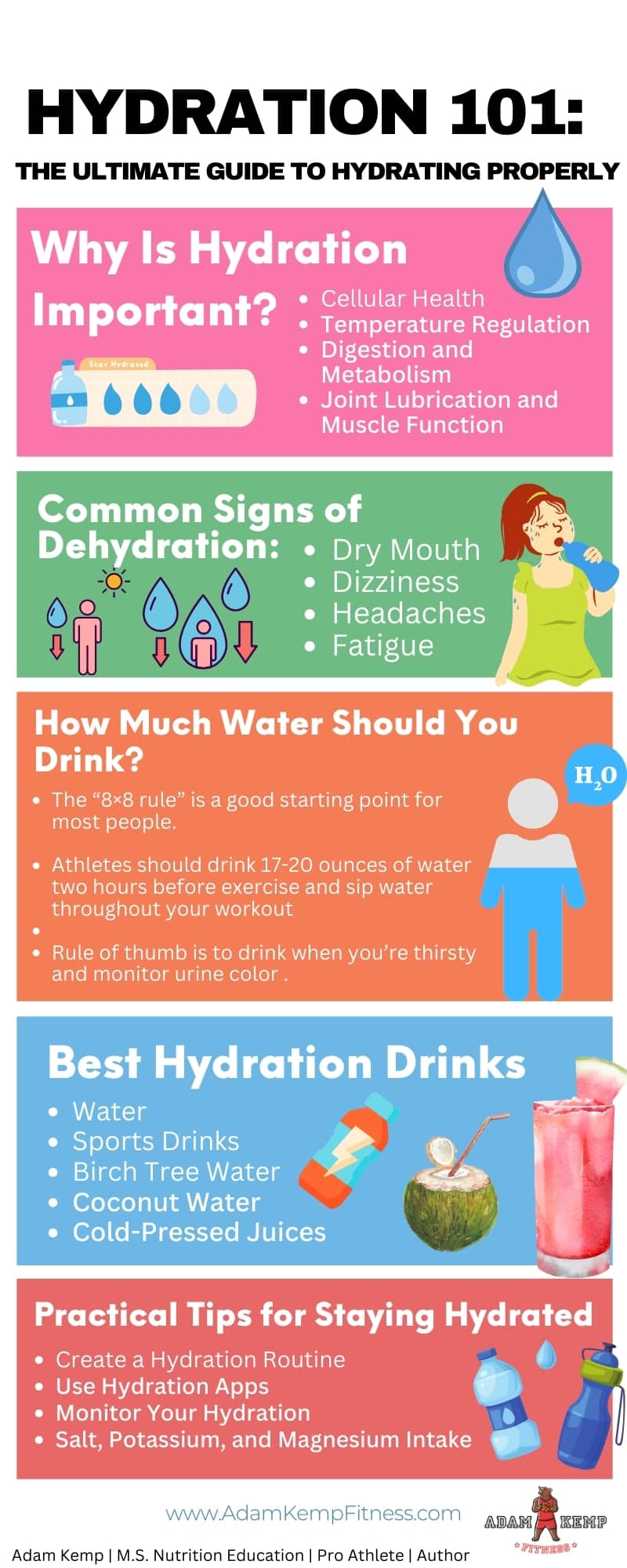Benefits of Sprint Workouts: Is Running Sprints Good for You?
Sprinting is not just for athletes and sports development; it is a highly effective way for many people to improve their shape and overall health.
Unlike traditional endurance training, sprint workouts, also known as sprint interval training (SIT), offer unique benefits while requiring significantly less time.
Research highlights that sprinting protocols involving shorter, high-intensity sprints can unlock substantial health advantages for a variety of populations, from elite athletes to sedentary individuals (Vollaard & Metcalfe, 2017).
By incorporating sprint training into your fitness routine, you can reduce body fat, improve insulin sensitivity, build lower-body strength and power, improve muscle endurance, and sculpt your abdominal muscles and midsection.
In this article, we’ll explore some of the top benefits of sprint workouts and how they can help you achieve your fitness goals!
What is a Sprint Workout (AKA Sprint Interval Training)?
A sprint workout, also known as Sprint Interval Training (SIT), is a high-intensity training method that alternates short bursts of maximal or near-maximal effort sprints with periods of rest or low-intensity recovery.
This form of exercise is designed to maximize cardiovascular and metabolic adaptations in a shorter amount of time compared to traditional steady-state workouts.
Key Characteristics of Sprint Workouts
- Intensity: Each sprint is performed at maximum or near-maximum effort, typically between 85% and 100% of your capacity.
- Duration: Sprint intervals usually last between 10 to 30 seconds, depending on the protocol and fitness level.
- Recovery: Rest periods are significantly longer than the sprint duration, ranging from 2 to 4 minutes to allow partial recovery before the next sprint.
- Repetitions: A typical session consists of 4 to 8 sprints, depending on your fitness level and the specific training goal.
Types of Sprint Workouts
- Running-Based SIT: Sprinting on a track, up a hill, field, or treadmill is the most common method.
- Cycling SIT: Performed on a stationary bike, such as using the Wingate protocol (30-second all-out sprints with 4 minutes rest).
- Field-Based SIT: Shuttle runs or cone drills, often used in sports-specific training.
How Sprint Workouts Work
Sprint workouts challenge both the aerobic and anaerobic energy systems.
- During sprints, the body rapidly depletes stored energy (ATP) and relies on glycolysis and phosphocreatine systems.
- In recovery, the aerobic system replenishes these stores and removes metabolic byproducts, improving overall energy efficiency.
Over time, this repeated stress leads to adaptations like improved cardiovascular health, increased muscle oxidative capacity, and enhanced power and endurance.
Benefits of Sprint Workouts

Sprint workouts offer a wide range of benefits, from improving cardiovascular health to enhancing physical appearance.
Whether your goal is to lose weight, build strength, or improve athletic performance, incorporating sprints into your fitness routine can help you achieve faster and more sustainable results.
- Efficiency: Achieve significant fitness and health improvements in less time compared to moderate-intensity continuous training (MICT).
- Weight Loss and Fat Burning: Burn more calories in a short time and boost fat metabolism through increased post-exercise oxygen consumption (EPOC).
- Aerobic and Anaerobic Gains: Enhance cardiovascular endurance and short-burst power by improving both aerobic and anaerobic energy systems.
- Lower-Body Strength and Power: Build strong hamstrings, glutes, and posterior chain muscles for explosive strength and athletic performance.
- Muscle Building and Endurance: Develop fast-twitch muscle fibers for power while improving endurance for sustained activity.
- Core Strength and Sculpted Abs: Strengthen and tone the abdominal muscles and improve core stability for a lean, athletic physique.
- Versatility and Adaptability: Customize sprints to your fitness level and goals, offering variety and scalability for beginners and advanced athletes alike.
1.) Efficiency
Sprint Interval Training (SIT) is one of the most time-efficient ways to improve fitness.
Research has shown that SIT provides health benefits comparable to or even greater than moderate-intensity continuous training (MICT) in significantly less time (Vollaard & Metcalfe, 2017).
This makes sprint workouts ideal for those with busy schedules.
2.) Weight Loss and Fat Burning
Sprinting is a highly effective exercise for weight loss, and there are a variety of different sprint workouts for weight loss.
Its intense nature burns a significant number of calories in a short period and stimulates excess post-exercise oxygen consumption (EPOC), boosting fat metabolism even after the workout is complete.
Studies have found that sprint workouts can increase insulin sensitivity and fat oxidation, particularly in overweight or sedentary individuals.
This makes sprinting a powerful tool for reducing body fat and improving metabolic health.
Since sprint workouts can help you burn a lot of calories in a short amount of time, they are clearly one of the best exercises for weight loss.
3.) Aerobic and Anaerobic Gains
Sprint workouts enhance both cardiovascular endurance and anaerobic capacity.
Repeated sprints improve maximal oxygen uptake (VO2 max) and boost the efficiency of both aerobic and anaerobic energy systems, which translates to better performance in a range of physical activities (Koral et al., 2017).
This dual benefit makes sprints a versatile option for improving overall fitness.
4.) Lower-Body Strength and Power
Sprinting engages the hamstrings, glutes, and posterior chain muscles, making it particularly effective for building lower-body strength and power.
By repeatedly pushing your body to maximum effort, you enhance muscle activation and develop explosive power.
This not only improves athletic performance but also supports functional strength for everyday activities.
5.) Muscle Building and Endurance
Sprint workouts challenge muscles in unique ways, promoting hypertrophy and endurance simultaneously.
The short, intense bursts of effort help build fast-twitch muscle fibers, while the recovery periods develop the endurance needed to sustain repetitive exertion.
This combination makes sprints an excellent complement to weightlifting programs, improving muscle endurance for more reps and sets.
6.) Core Strength and Sculpted Abs
Sprinting is one of the most effective exercises for toning and strengthening the abdominal and core muscles.
Every stride requires significant core stabilization, activating the abs, obliques, and lower back muscles.
Over time, this helps sculpt a defined midsection while improving overall stability and posture.
7.) Versatility and Adaptability
Sprint workouts can be tailored to suit any fitness level.
Beginners can start with shorter sprints and fewer repetitions, while experienced athletes can challenge themselves with longer distances and higher intensities.
Sprinting also adds variety to your workout routine, breaking the monotony of steady-state cardio or traditional weightlifting.
How to Warm Up for Running Sprints
A proper warm-up is essential for maximizing performance and preventing injury during sprint workouts.
Start with mini-band exercises to activate your lower body and glutes, including monster walks, lateral walks, and body squats.
Follow this with dynamic stretches such as leg swings, high knees, and butt kicks to improve flexibility and mobility.
Incorporate side shuffles, back pedals, and Carioca drills to prepare for faster movements.
Next, perform low to moderate-intensity plyometrics like pogo jumps, depth drops, agility ladder and jump squats to enhance explosiveness. Jump rope workouts are also useful because they are straightforward and can be done anywhere.
Finish by gradually increasing sprint intensity with 60%, 70%, and 80% effort sprints, ensuring your body is fully prepared for high-speed running.
This simple warm-up routine for sprinting primes your muscles, joints, and nervous system, setting the stage for optimal sprinting performance.
What to Eat and Drink Before Sprint Workouts
Proper nutrition and hydration are crucial for maximizing the benefits of sprint workouts, especially when it comes to burning fat.
However, it’s essential to time your pre-workout meal properly to avoid discomfort during your sprint workout.
Ideally, you should eat a meal containing complex carbohydrates and lean protein 2-3 hours before your workout.
This gives your body enough time to digest the food and provides the necessary fuel for your workout.
- If you’re short on time, a small snack containing carbohydrates and a small amount of protein 30 minutes before your workout can also be beneficial.
- Another option for those short on time is to consume a pre-workout supplement containing ingredients designed to boost energy, focus, and performance.
However, it’s important to be cautious when using these supplements and to read the labels carefully to ensure they don’t contain harmful ingredients.
Likewise, avoiding certain foods and beverages before your workout is important to maximize the benefits of your sprint workouts.
- For instance, consuming high-fat and high-fiber foods before your workout can cause stomach discomfort and slow digestion.
- Similarly, consuming sugary and high-carbohydrate foods can cause a rapid spike in blood sugar levels, leading to a crash in energy during your workout.
With that being said, here are some tips for what to eat and drink before sprint workouts to help you maximize performance and fat-burning.
Water or Low-Calorie Sports Drinks

Staying hydrated is crucial for any workout, including sprint workouts.
Dehydration can lead to decreased performance, fatigue, and even injury.
Drinking water before and during your sprint workout can help to keep you hydrated and improve your overall performance.
If you did not have an adequate pre-workout meal, are sprinting in intense heat, or believe your workout will last longer than 1.5 hours, you can consider a healthy, natural sports drink option like Prime Hydration or Gatorade Fit.
Complex Carbohydrates
Eating complex carbohydrates before your sprint workout can give your body the fuel it needs to perform at its best.
Whole grains, fruits, and vegetables are excellent sources of complex carbohydrates that can provide sustained energy throughout your workout.
Lean Protein
Incorporating lean protein into your pre-workout meal can help to preserve muscle mass and promote fat burning.
Lean protein sources such as chicken, turkey, fish, and tofu are great options for your pre-workout meal.
Eating protein before your workout can also help to reduce muscle damage and promote recovery post-workout.
Protein powder supplements are another great option for pre-workout protein needs. My favorite protein powder is Garden of Life Protein and Greens.
Last update on 2025-07-05 / This article includes affiliate links/Images via Amazon Product Advertising API. I may earn commissions on purchases made through these links.
Ergogenic Supplements
Ergogenic supplements are substances that can enhance athletic performance.
Caffeine is a popular ergogenic supplement that can help to improve performance during sprint workouts.
Green tea and coffee are excellent natural sources of caffeine, and pre workout supplements commonly contain caffeine and other ergogenic substances.
If you are trying to lose weight, drinking green tea before a workout is an evidence-based approach to improve workout performance and boost weight loss.
For these reasons, I commonly suggest people drink 3-5 cups of green tea each day for weight loss.
Another supplement that can help to enhance performance during sprint workouts is beta-alanine, which can help to reduce muscle fatigue and improve endurance.
Consuming a pre workout supplement like Optimum Nutrition Gold Standard Pre Workout is an excellent option as it contains caffeine, beta alanine, and other performance-enhancing ingredients.
Last update on 2025-07-05 / This article includes affiliate links/Images via Amazon Product Advertising API. I may earn commissions on purchases made through these links.
Final Thoughts: Is Sprinting Good for Everyone?
Sprinting is a highly effective and efficient exercise, but its suitability depends on individual fitness levels, goals, and health conditions.
While sprint workouts offer tremendous benefits—such as improved cardiovascular health, fat loss, and muscle building—their high-intensity nature may not be ideal for everyone.
For beginners or those with underlying health issues, starting with modified sprint intervals or lower-intensity exercises is crucial to avoid injury and build a solid fitness foundation.
Consulting with a healthcare provider or fitness professional can help determine whether sprinting is appropriate and how to tailor a program safely.
For most people, sprinting can be a valuable addition to a fitness routine when approached correctly.
Its adaptability and scalability make it a versatile tool for achieving various health and performance goals.
Whether you’re an athlete or just starting your fitness journey, sprinting has the potential to deliver powerful results when done with proper preparation and care.
This website does not provide medical advice. This website site does contain affiliate links, and purchases may earn a commission.
Read my Medical Disclaimer, Review Disclaimer, and Publishing Policies for more details. Use of this site indicates acceptance of these terms.





